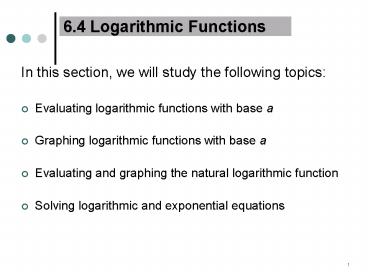6.4 Logarithmic Functions - PowerPoint PPT Presentation
1 / 24
Title:
6.4 Logarithmic Functions
Description:
6.4 Logarithmic Functions In this section, we will study the following topics: Evaluating logarithmic functions with base a Graphing logarithmic functions with base a – PowerPoint PPT presentation
Number of Views:178
Avg rating:3.0/5.0
Title: 6.4 Logarithmic Functions
1
6.4 Logarithmic Functions
- In this section, we will study the following
topics - Evaluating logarithmic functions with base a
- Graphing logarithmic functions with base a
- Evaluating and graphing the natural logarithmic
function - Solving logarithmic and exponential equations
2
Logarithmic Functions
Now that you have studied the exponential
function, it is time to take a look at its
INVERSE THE LOGARITHMIC FUNCTION. In the
exponential function, the independent variable
(x) was the exponent. So we substituted values
into the exponent and evaluated it for a given
base. Exponential Function f(x) 2x, f(3)
23 8.
3
Logarithmic Functions
For the inverse function (LOGARITHMIC FUNCTION),
the base is given and the answer is given, so to
evaluate a logarithmic function is to find the
exponent. That is why I think of the
logarithmic function as the Guess That Exponent
function.
Warm Up Give the value of ? in each of the
following equations.
4
Subliminal Message
Exponential and logarithmic functions of the same
base are inverses. Exponential and logarithmic
functions of the same base are inverses. Exponenti
al and logarithmic functions of the same base are
inverses. Exponential and logarithmic functions
of the same base are inverses. Exponential and
logarithmic functions of the same base are
inverses. Exponential and logarithmic functions
of the same base are inverses. Exponential and
logarithmic functions of the same base are
inverses. Exponential and logarithmic functions
of the same base are inverses. Exponential and
logarithmic functions of the same base are
inverses.
5
Logarithmic Functions (continued)
Evaluate log28
To evaluate log28 means to find the exponent
such that 2 raised to that power gives you 8.
6
Logarithmic Functions (continued)
The following definition demonstrates this
connection between the exponential and the
logarithmic function.
Definition of a Logarithmic Function For x gt 0, a gt 0, and a ? 1, y logax if and only if x ay
We read logax as log base a of x.
7
Converting Between Exponential and Logarithmic
Forms
y logax if and only if x ay
I. Write the logarithmic equation in exponential
form. a) b) II. Write the exponential
equation in logarithmic form. a) b)
8
Evaluating Logarithms w/o a Calculator
To evaluate logarithmic expressions by hand, we
can use the related exponential expression.
Example Evaluate the following logarithms
The plan is to convert to exponential form.
9
Evaluating Logarithms w/o a Calculator (cont.)
10
Evaluating Logarithms w/o a Calculator
Okay, try these. ? e)
f) g)
h)
11
The Common Logarithm
The common logarithm has a base of 10. If the
base of a logarithm is not indicated, then it is
assumed that the base is 10.
12
Graphs of Logarithmic Functions
Since the logarithmic function is the
_______________ of the exponential function (with
the same base), we can use what we know about
inverse functions to graph it. ExampleGraph
f(x) 2x and g(x) log2x in the same
coordinate plane. To do this, we will make a
table of values for f(x)2x and then switch the
x and y coordinates to make a table of values for
g(x).
13
Graphs of Logarithmic Functions (continued)
Inverse functions
f(x) 2x g(x) log2x
x f(x)
-4
-2
0
2
4
x g(x)
14
Comparing the Graphs of Exponential and Log
Functions
- Notice that the domain and range of the inverse
functions are switched. - The exponential function has
- domain (-?, ?)
- range (0, ?)
- HORIZONTAL asymptote y 0
- The logarithmic function has
- domain (0, ?)
- Range (-?, ?)
- VERTICAL asymptote x 0
15
Transformations of Graphs of Logarithmic Functions
The same transformations we studied earlier also
apply to logarithmic functions. Look at the
following shifts and reflections of the graph of
f(x) log2x.
The new vertical asymptote is x -2
16
Transformations of Graphs of Logarithmic Functions
17
The Natural Logarithmic Function
In section 6.3, we saw the natural exponential
function with base e. Its inverse is the natural
logarithmic function with base e. Instead of
writing the natural log as logex, we use the
notation , which is read as the natural
log of x and is understood to have base e.
18
Natural Log Key
- To evaluate the natural log using the TI-83/84,
use the ? button. - Notice, the 2nd function of this key is ________.
19
Graph of the Natural Exponential and Natural
Logarithmic Function
f(x) ex and g(x) ln x are inverse functions
and, as such, their graphs are reflections of one
another in the line y x.
20
Evaluating the Natural Log
Evaluate without using a calculator. a)
b) c) d) e) f)
21
Solving Logarithmic Equations
Strategy for solving logarithmic equations Change the equation from a log equation into an exponential equation, using one of the following forms logax y ? x ay logx y ? x 10y lnx y ? x ey
Keep in mind that the domain of the log function
is xgt0. Reject any extraneous solutions!!
22
Examples of solving log equations
23
More examples of solving log equations
24
- End of Section 6.4































